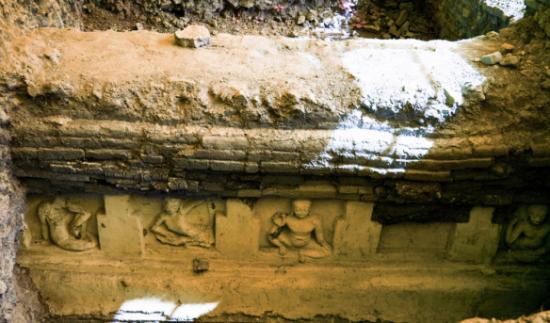Source - http://timesofindia.indiatimes.com/city/kolkata/Six-terracotta-tablets-found-at-Moghalmari/articleshow/28720999.cms

Six terracotta tablets were discovered from the excavation site atMoghalmari on Saturday evening, a couple of kilometres from Dantan in West Midnapore district.
The Moghalmari mound is being excavated by the state archaeology department in an effort to unearth the oldest historical site of the state. A Buddhist monastery, dating back to the 5{+t}{+h} century, is gradually getting unveiled from below the mound.
Two artifacts that had been discovered earlier indicated the antiquity of the site. The inscriptions found on these two artifacts were later deciphered by historians in the city and cemented the claim. Saturday's discovery of the six terracotta tablets has further strengthened it.
However, despite the relevance of the monastery's antiquity, its name is yet to be ascertained since the seal in which the name of the monastery is inscribed is yet to be deciphered. The most important find of any archaeological site is the discovery of this seal.
The six terracotta tablets were found lying inside a container that was kept below a staircase; that too has been unearthed intact. Brahmi inscriptions have also been found on these tablets that read the equivalent of, 'Ye darma hetu prabhabo...maha shaman', indicating clearly that the site was a prominent and proliferating vihara (monastery) of the times.
Earlier, a gold coin and a locket were found here bearing the Brahmi inscription, 'Maharajadhiraja Samachar Devo', indicating the fact that the vihara was in use at the time of the independent Bengal king, Samachar Dev, who ruled Bengal during the time of Kumar Gupta.
"The terracotta tablets that we found here are unique. They have herbal and medicinal value and were used as incense tablets to be burnt inside earthen bowls. It was believed that when the tablets smouldered gradually, the perfume spread the message of the Buddhist dharma," explained Amal Roy, deputy director of the state archaeology department.
The Mogolmari mound was first discovered in 2003 by Indologist BN Mukherjee who visited Dantan to document Bengal's navigational history. The locals called the mound Sakhi Sena or Sashi Sena. Locals told him that underneath the mound lay an ancient Buddhist monastery. Mukherjee tried to link it up to the accounts of Chinese scholar Hiuen Tsang who had categorically mentioned that an old Buddhist monastery existed in Bengal, and was older than the Raktamrittika Vihara of Murshidabad.
Calcutta University started excavating the site in 2004 and did it in several phases till 2012 to arrive at the conclusion that a Buddhist vihara existed underneath the massive mound of Mogalmari, that developed in two phases from sixth to seventh centuries and then again from ninth to tenth centuries. However, due to lack of funds and several other infrastructural shortcomings, the university could not continue to excavate the mound. The state archaeology department took it over and started re-excavating the site from November 20.
The state archaeology department has gradually excavated a tri-ratha type of structure that is typical of the Buddhist monastic architecture, complete with many cells lined on all four sides. "It is clear from the coin, locket and now tablets that the monastery got a lot of royal attention but Hiuen Tsang's memoirs indicate that merchants at the Dantan port also frequented the monastery," said Rajat Sanyal, an archaeologist from CU who was connected with the project.
A large number of deities have been unearthed during the course of the excavation and historians feel that the monastery was built during the Vajrayana phase of Buddhism.